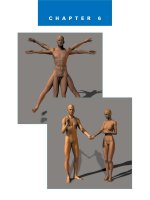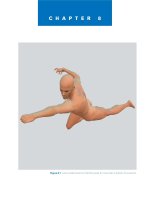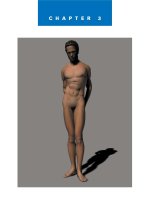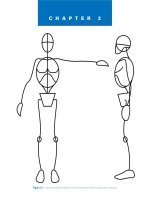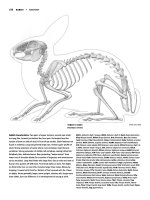Figure drawing basics
Bạn đang xem bản rút gọn của tài liệu. Xem và tải ngay bản đầy đủ của tài liệu tại đây (1.65 MB, 23 trang )
1
Cartooning–Concepts and Methods Part 1: Figure Drawing Basics, ™ and © Don Simpson 2000, all rights reserved. For individual use only. Classroom use without express written permis-
sion is strictly forbidden. Please email for information. Published by Fiasco Comics Inc., PO Box 64, Wexford, PA 15090. www.MEGATONMAN.com
Part 1: Figure Drawing Basics—Action & Structure
2
Cartooning–Concepts and Methods Part 1: Figure Drawing Basics, ™ and © Don Simpson 2000, all rights reserved. For individual use only. Classroom use without express written permis-
sion is strictly forbidden. Please email for information. Published by Fiasco Comics Inc., PO Box 64, Wexford, PA 15090. www.MEGATONMAN.com
In our methodical approach to building up your confidence as an artist,
we're going to tackle something simple at first—our friend the stick
figure. Go ahead, draw one right now!
A reasonable stick figure at this point should contain a midline for the
spine, two arms, two legs, and a circle for the head. Fingers for hands
and lines for feet are optional, but being the conscientious craftsman
that you are, I know you'll want to include them.
Now draw your stick figure running, jumping, falling, walking, running,
climbing—see how many poses you can come up with. The record is
4096!
Don't worry about niceties like exact proportions at this point. Getting
your point across is everything. We'll be getting fancier a little later on.
The Stick Figure
3
Cartooning–Concepts and Methods Part 1: Figure Drawing Basics, ™ and © Don Simpson 2000, all rights reserved. For individual use only. Classroom use without express written permis-
sion is strictly forbidden. Please email for information. Published by Fiasco Comics Inc., PO Box 64, Wexford, PA 15090. www.MEGATONMAN.com
Okay, so anybody can draw a simple stick figure. But the point I'm trying to get across here is that, more
importantly, everyone recognizes what a stick figure represents—a person! Isn't that amazing?
Cartoonists are able to communicate even with the most elementary of pictures. Show your drawings to your
friends and see if they can tell what your stick figures are doing. If they misidentify some of your drawings,
that's okay. Many poses will be open to interpretation. Just compliment them on their keen perception and
head back to the drawing board!
Conveying specific actions and even emotional states of mind with a few quick lines—and I dare say as few
lines as possible—is an important first step towards drawing fully realized figures. If you can accomplish that
with your limited stick figures, think of what you can accomplish with even more tools at your disposal.
4
Cartooning–Concepts and Methods Part 1: Figure Drawing Basics, ™ and © Don Simpson 2000, all rights reserved. For individual use only. Classroom use without express written permis-
sion is strictly forbidden. Please email
for information. Published by Fiasco Comics Inc., PO Box 64, Wexford, PA 15090. www.MEGATONMAN.com
A More Sophisticated Stick Figure
Let's use a slightly more
sophisticated stick figure,
one that is shaped a little
more like an adult person.
As before, don't be overly
concerned with correct
proportions right now. Stay
focussed on depicting
actions--leaping, swinging,
golfing, rowing, sitting, etc.
We've added a line across the
shoulders and a line across
the hips, as well as definite
elbow and knee joints. Don't
worry about making your
sticks perfectly straight lines,
either—in fact, slightly curvy
lines are more human. And
don't even worry about
getting the curves right,
either—just go with what-
ever feels right.
Again, test your drawings out
on others. If people can tell
what activities your stick
figures are involved in, you're
doing great!
5
Cartooning–Concepts and Methods Part 1: Figure Drawing Basics, ™ and © Don Simpson 2000, all rights reserved. For individual use only. Classroom use without express written permis-
sion is strictly forbidden. Please email
for information. Published by Fiasco Comics Inc., PO Box 64, Wexford, PA 15090. www.MEGATONMAN.com
Our new, sleeker stick figure seems to lend itself to more graceful
and athletic themes. But try comical situations as well. You may
even use some of your 4096 poses you came up with for the
shorter, stubbier stick figure and see if they can be translated to
the more sophisticated model.
Your friends may tell you they like your older, funnier work
better—don't be discouraged! Keep right on drawing.
6
Cartooning–Concepts and Methods Part 1: Figure Drawing Basics, ™ and © Don Simpson 2000, all rights reserved. For individual use only. Classroom use without express written permis-
sion is strictly forbidden. Please email for information. Published by Fiasco Comics Inc., PO Box 64, Wexford, PA 15090. www.MEGATONMAN.com
The 3 Basic Solids
It's time to let you in on a
little secret. The stick figure
makes such a convincing
person because it represents,
in a minimalistic way, what
all people have got inside
them—a skeleton! The
spine, the arms, the legs—all
are represented in a simpli-
fied way in a stick figure.
With the skeleton in mind,
we can now add three shapes
to our stick figures to make
them more real, one of
which we already have: the
skull (the head), the rib cage
(the chest), and the pelvis
(hip bone). These are the
three largest bony masses in
the body. Use simple ovals
for right now.
7
Cartooning–Concepts and Methods Part 1: Figure Drawing Basics, ™ and © Don Simpson 2000, all rights reserved. For individual use only. Classroom use without express written permis-
sion is strictly forbidden. Please email for information. Published by Fiasco Comics Inc., PO Box 64, Wexford, PA 15090. www.MEGATONMAN.com
After you've drawn the spine,
arms and legs to establish the
action of your stick figure,
proceed to add the chest,
hips and head to begin flesh-
ing things out. See how
quickly things are taking
shape?
Keep the focus on the action, first
and foremost. If your drawings
don't communicate the story your
trying to tell, all the ovals in the
world aren't going to help you.
Build on a solid foundation:
action and emotion!
8
Cartooning–Concepts and Methods Part 1: Figure Drawing Basics, ™ and © Don Simpson 2000, all rights reserved. For individual use only. Classroom use without express written permis-
sion is strictly forbidden. Please email
for information. Published by Fiasco Comics Inc., PO Box 64, Wexford, PA 15090. www.MEGATONMAN.com
The Main Line of Action
The first thing you need to
determine is the main line of
action for your figure. For
all intents and purposes, that
is synonymous with the
spine. The first line you
should put down on paper
should be that line—it deter-
mines the entire thrust for
the rest of the figure. Limbs
and even the head branch off
from that.
Notice how the three basic
solids—chest, skull and
pelvis—relate to each other
differently depending upon
the arc of the spine.
Continue the sweep of your
pose into the arms and legs.
Keep your figures moving!
It's important to never lose
sight of your stick figure,
because it represent the
skeleton. And where bone
goes, flesh will surely follow!
9
Cartooning–Concepts and Methods Part 1: Figure Drawing Basics, ™ and © Don Simpson 2000, all rights reserved. For individual use only. Classroom use without express written permis-
sion is strictly forbidden. Please email
for information. Published by Fiasco Comics Inc., PO Box 64, Wexford, PA 15090. www.MEGATONMAN.com
Okay, so now every pose is starting to look like dancing.
Oh well. You get the point.

